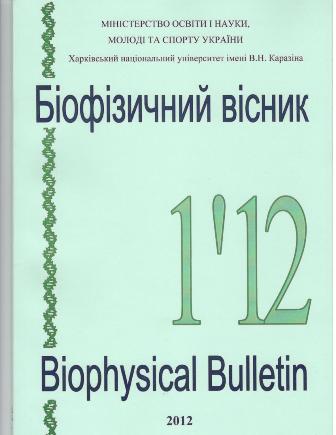Induced with cationic porphyrin, aggregation of carbon nanotubeoligonucleotide: temperature effect on hybrid stability
Abstract
Being controlled, aggregation of carbon nanotubes covered with single stranded DNA permits to prepare isolated nanotubes of high density in water suspension and promotes their integration into multifunctional structures and devices. System consisting of two (10,0) nanotubes wrapped with (rC)30 and connected with 4 molecules of cationic porphyrin TMPyP4 was simulated by molecular dynamics during 30 ns (at 300 K). All this time the aggregate studied was stable in water medium. The increase of the system temperature to 373 K and the following simulation during 10 ns do not result in decomposition of the aggregate of two nanotubes. It was revealed that new contacts appear, intensifying the binding of tubes both due to the polymer displacement from the tube to the neighbor one as well as due to two oligomer binding through dimmer/trimer stacking of cytosines and hydrogen-bound dimer of cytosines belonging to two (rC)30. It should be noted that porphyrins placed on the tube surface between two pitches strengthen the oligomer on the tube and restrain its slide from the nanotube.
Downloads
References
2. DNA-Assisted Dispersion and Separation of Carbon Nanotubes / M. Zheng, A. Jagota, E. Semke, [et al.] // Nature Mater. – 2003. - V. 2. - P. 338-342.
3. Assembly of Single-Walled Carbon Nanotubes on DNA-Origami Templates through Streptavidin–Biotin Interaction / A.-P. Eskelinen, A. Kuzyk, T.K. Kaltiaisenaho, [et al.] // Small – 2011. - V. 7. - P. 746–750.
4. RNA-Wrapped Carbon Nanotubes Aggregation Induced by Polymer Hybridization / V.A. Karachevtsev, G.O. Gladchenko, M.V. Karachevtsev, [et al.] // Mol. Cryst. Liq. Cryst. – 2008. - V. 497. - P. 339-351.
5. Nanohybrid Structures Formed by Carbon Nanotubes with Long Polynucleotide / V.A. Karachevtsev, M.V. Karachevtsev, V.S. Leontiev, [et al.] // Fullerenes, Nanotubes, Carbon Nanostruct. – 2010. - V. 18. - P. 531–537.
6. Barone P.W. Reversible Control of Carbon Nanotube Aggregation for a Glucose Affinity Sensor / P.W. Barone, M.S. Strano // Angew. Chem. Int. Ed. – 2006. - V. 45. - P. 8138 –8141.
7. Chen R. J. Controlled Precipitation of Solubilized Carbon Nanotubes by Delamination of DNA / R.J. Chen, Y. Zhang // J. Phys. Chem. B – 2006. - V. 110. - P. 54-57.
8. Porphyrin Assemblies on DNA as Studied by a Resonance Light-Scattering Technique / R.F. Pasternack, C. Bustamante, P.J. Collngs, [et al.] // J. Am. Chem. Soc. – 1993. - V. 115. - P. 5393-5399.
9. Raman Spectroscopy and Theoretical Characterization of Nanohybrids of Porphyrins with Carbon Nanotubes / V.A. Karachevtsev, E.S. Zarudnev, S.G. Stepanian, [et al.] // J. Phys. Chem. C – 2010. - V. 114. - P. 16215–16222.
10. Bionano Donor Acceptor Hybrids of Porphyrin, ssDNA, and Semiconductive Single-Wall Carbon Nanotubes for Electron Transfer via Porphyrin Excitation / F. D’Souza, S.K. Das, M.E. Zandler, [et al.] // J. Am. Chem. Soc. – 2011. - V. 133. - P. 19922–19930.
11. Unusual Aggregation of Poly(rC)-wrapped Carbon Nanotubes in Aqueous Suspension Induced by Cationic Porphyrin / E.S. Zarudnev, A.M. Plokhotnichenko, V.S. Leontiev, [et al.] // J. Mater. Chem. – 2012. - V. 22. - P. 10795-10804.
12. Scalable Molecular Dynamics with NAMD / C. Phillips, R. Braun, W. Wang, [et al.] // J. Comput. Chem. – 2005. - V. 26. - P. 1781-1802.
13. Foloppe N. All-atom Empirical Force Field for Nucleic Acids: Parameter Optimization Based on Small Molecule and Condensed Phase Macromolecular Target Data / N. Foloppe, A.D. MacKerell Jr. // J. Comput. Chem. – 2000. - V. 21. - P. 86-104.
14. Humphrey W. VMD: Visual Molecular Dynamics / W. Humphrey, A. Dalke, K. Schulten // J. Molec. Graphics – 1996. - V. 14. - P. 33-38.
Authors who publish with this journal agree to the following terms:
- Authors retain copyright and grant the journal right of first publication with the work simultaneously licensed under a Creative Commons Attribution License that allows others to share the work with an acknowledgement of the work's authorship and initial publication in this journal.
- Authors are able to enter into separate, additional contractual arrangements for the non-exclusive distribution of the journal's published version of the work (e.g., post it to an institutional repository or publish it in a book), with an acknowledgement of its initial publication in this journal.
- Authors are permitted and encouraged to post their work online (e.g., in institutional repositories or on their website) prior to and during the submission process, as it can lead to productive exchanges, as well as earlier and greater citation of published work (See The Effect of Open Access).





